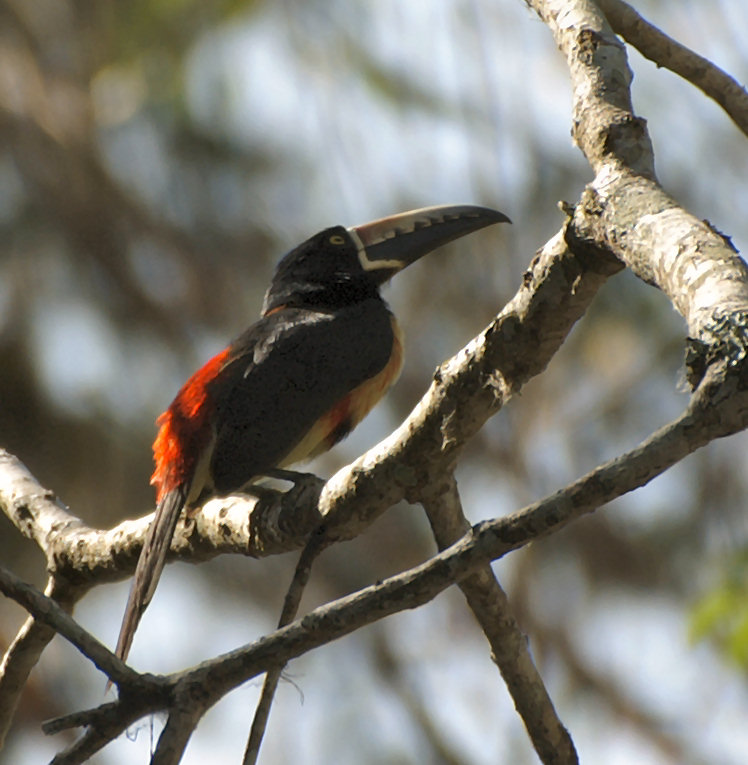| New Photos | Animal News | Animal Sounds | Animal Movies | Upload Photo | Copyright | Korean |
|---|
| Funny Animal Photos | Monsters in Animalia | Wiki Articles Fun Facts about Animals | Links | Home | Mobile A.P.A. |
|---|
| Image Info | Original File Name: 194L67-Collared Aracari (Pteroglossus torquatus).jpg Resolution: 748x765 File Size: 157468 Bytes Date: 2007:04:29 09:35:08 Camera: MAXXUM 7D (KONICA MINOLTA ) F number: f/5.6 Exposure: 1/350 sec Focal Length: 3000/10 Upload Time: 2007:12:10 18:01:03 | |
| Author | Name (E-mail): Unknown | |
| Subject | Collared Aracari (Pteroglossus torquatus) - Wiki | |
 |
| Email : E-Card | Poster | Web Master Delete Edit Info Admin |
| Description | Collared Aracari (Pteroglossus torquatus) - Wiki
Collared Aracari
The Collared Aracari, Pteroglossus torquatus, is a toucan, a near-passerine bird which breeds from southern Mexico to Panama; also Ecuador, Colombia and Venezuela. Description Like other toucans, the Collared Aracari is brightly marked and has a large bill. The adult is typically 41 cm long and weighs 230 g. The sexes are alike in appearance, with a black head and chest and dark olive green upperparts, apart from a red rump and upper tail. There is reddish collar on the rear neck which gives rise to the English and scientific (torquatus) names The underparts are bright yellow, with a round black spot in the centre of the breast and a red-tinted black band across the belly. The thighs are chestnut. The bare facial skin is black, becoming ruddy behind the yellow eye. The upper mandible of the bill is dull yellow, marked with a black saw-tooth pattern on the cutting edge, and a black tip. The lower mandible is black, and the legs are green. Juvenile Collared Aracaris are much duller, with sooty-black head and brownish green upperparts. The red rump and yellow underparts are paler, and the breast spot, belly band and bill pattern are indistinct. The call of the Collared Aracari is a loud, sharp pseek, or peeseek. Behaviour Small flocks, usually consisting of 6-15 birds, move through the forest with a rapid direct flight. This species is primarily an arboreal fruit-eater, but will also take insects, lizards, bird eggs, and other small prey. Reproduction The Collared Aracari is a common resident breeder in lowland forests and slightly more open woodland. The 3 white eggs are laid in an unlined natural cavity or old woodpecker nest high in a tree. Both sexes incubate the eggs for about 16 days, and the toucan chicks remain in the nest after hatching. They are blind and naked at birth, and have short bills and specialised pads on their heels to protect them from the rough floor of the nest. They are fed by both parents, assisted by up to three other adults, probably from a previous brood, and fledge after about 6 weeks, with feeding by the adults continuing for several weeks after leaving the nest. The aracaris are unusual for toucans in that they roost socially throughout the year, up to six adults and fledged young sleeping in the same hole with tails folded over their backs. http://en.wikipedia.org/wiki/Collared_Aracari
| |||
| Copyright Info | AnimmalPicturesArchive.com does not have the copyright for this image. This photograph or artwork is copyright by the photographer or the original artist. If you are to use this photograph, please contact the copyright owner or the poster. |
|
|
|
| |||||||
| CopyLeft © since 1995, Animal Pictures Archive. All rights may be reserved. | ||||||||
Stats